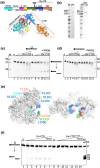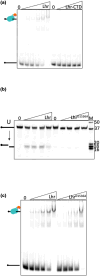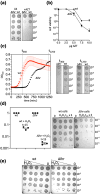Escherichia coli DNA repair helicase Lhr is also a uracil-DNA glycosylase
- PMID: 37452011
- PMCID: PMC10953399
- DOI: 10.1111/mmi.15123
Escherichia coli DNA repair helicase Lhr is also a uracil-DNA glycosylase
Abstract
DNA glycosylases protect genetic fidelity during DNA replication by removing potentially mutagenic chemically damaged DNA bases. Bacterial Lhr proteins are well-characterized DNA repair helicases that are fused to additional 600-700 amino acids of unknown function, but with structural homology to SecB chaperones and AlkZ DNA glycosylases. Here, we identify that Escherichia coli Lhr is a uracil-DNA glycosylase (UDG) that depends on an active site aspartic acid residue. We show that the Lhr DNA helicase activity is functionally independent of the UDG activity, but that the helicase domains are required for fully active UDG activity. Consistent with UDG activity, deletion of lhr from the E. coli chromosome sensitized cells to oxidative stress that triggers cytosine deamination to uracil. The ability of Lhr to translocate single-stranded DNA and remove uracil bases suggests a surveillance role to seek and remove potentially mutagenic base changes during replication stress.
Keywords: DNA repair; DNA replication; glycosylase; helicase; uracil.
© 2023 The Authors. Molecular Microbiology published by John Wiley & Sons Ltd.
Figures




Similar articles
-
Uracil DNA glycosylase (UDG) activities in Bradyrhizobium diazoefficiens: characterization of a new class of UDG with broad substrate specificity.Nucleic Acids Res. 2017 Jun 2;45(10):5863-5876. doi: 10.1093/nar/gkx209. Nucleic Acids Res. 2017. PMID: 28369586 Free PMC article.
-
Role of endonuclease III enzymes in uracil repair.Mutat Res. 2019 Jan;813:20-30. doi: 10.1016/j.mrfmmm.2018.12.001. Epub 2018 Dec 14. Mutat Res. 2019. PMID: 30590231 Free PMC article.
-
Structure and function in the uracil-DNA glycosylase superfamily.Mutat Res. 2000 Aug 30;460(3-4):165-81. doi: 10.1016/s0921-8777(00)00025-2. Mutat Res. 2000. PMID: 10946227 Review.
-
Crystal structure of Escherichia coli uracil DNA glycosylase and its complexes with uracil and glycerol: structure and glycosylase mechanism revisited.Proteins. 1999 Apr 1;35(1):13-24. Proteins. 1999. PMID: 10090282
-
Structure and function of the uracil DNA glycosylases from hyperthermophiles: Elucidating DNA uracil repair mechanisms: A review.Int J Biol Macromol. 2025 Apr;299:140137. doi: 10.1016/j.ijbiomac.2025.140137. Epub 2025 Jan 20. Int J Biol Macromol. 2025. PMID: 39842587 Review.
References
-
- Almatarneh, M.H. , Flinn, C.G. & Poirier, R.A. (2008) Mechanisms for the deamination reaction of cytosine with H2O/OH(−) and 2H2O/OH(−): a computational study. Journal of Chemical Information and Modeling, 48(4), 831–843. - PubMed
-
- Buttner, K. , Nehring, S. & Hopfner, K.P. (2007) Structural basis for DNA duplex separation by a superfamily‐2 helicase. Nature Structural & Molecular Biology, 14(7), 647–652. - PubMed
Publication types
MeSH terms
Substances
Grants and funding
LinkOut - more resources
Full Text Sources
Miscellaneous

